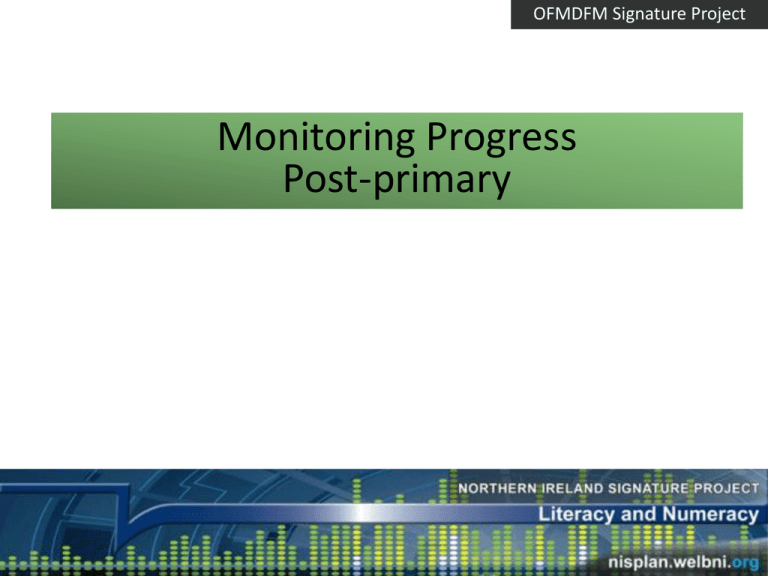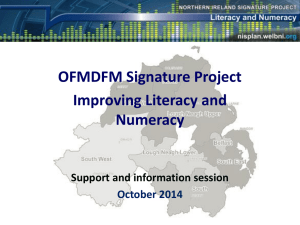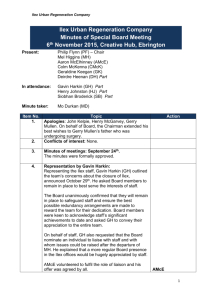Monitoring and Evaluation
advertisement

OFMDFM Signature Project Monitoring Progress Post-primary OFMDFM Signature Project Aims of the session To consider how you are monitoring progress in relation to • Targets on your Action Plan (school level) • Identified pupils in the focus group (Pupil level) OFMDFM Signature Project Monitoring • • • • • • • Why? Who? When? What? How? Open, shared and transparent? Linked to targets on action plan? Pupil targets? Improving Learning Baseline What do we know about the pupil? EVALUATE OUTCOMES AND IMPACT MONITOR PROGRESS EVIDENCE BASE MAKE CHANGES Implement-Teach SET TARGETS and Plan QUANTITATIVE AND QUALITATIVE OFMDFM Signature Project What is Monitoring? Monitoring is the activity that is undertaken routinely to keep a check on progress and to check that what is supposed to be happening is happening in the way that was planned OFMDFM Signature Project Monitoring and Evaluation School level • Action plan aligned with the school’s school development plan • Action plan/s completed using NISPLAN website (English, Mathematics, Irish) by 30th October • Baseline performance data recorded on school action plan/s (key stage 2 / GCSE) • Performance targets set for 2013-14 • Monitoring of progress through the NISPLAN website (December, February) • Analysis of qualitative and quantitative data • Self-Evaluation by participating teachers • Evaluation of the project (June) OFMDFM Signature Project Monitoring and Evaluation Pupil level • Individual pupils identified for support using performance data • Baseline information recorded for individual pupils • Targets and success criteria set for individual pupils • Detail of specific intervention planned • Monitoring of individual pupil progress against performance targets (December and February) • Pupil questionnaires and attitudinal studies used OFMDFM Signature Project Monitoring and Evaluation System level • Assessment of action plans through the NISPLAN website • Monitoring of progress through the NISPLAN website (December, February) • Analysis of qualitative and quantitative data • Progress measured against PfG targets and Count, Read: Succeed milestones • Sharing of effective practice through the NISPLAN website and teacher training sessions • Principal information sessions/ meetings • CASS officer information sessions and workshops • Evaluation of training and support for teachers • Progress updates and evaluation reports to the WELB implementation team, ASEO group, SOG, DE, ETI OFMDFM Signature Project Process • Monitor pupils’ progress first against individual targets set • Quantify the information you have gained from this monitoring • Look at the targets on your Action plan- Are you on track? If not, Why not? • Use this information to complete the monitoring form on the website OFMDFM Signature Project “How are we doing? How do we know?” • What are you measuring against? • What evidence do you have to support your monitoring? • What are you doing with the results of your monitoring? • Who is informed by this information? • What will you do differently? OFMDFM Signature Project Sources of Evidence for monitoring pupil progress • • • • • • • • Samples of work/ tasks/ tests Your observations/ records Pupil’s opinions/attitudes Pupil Learning Logs Parents’ opinions Transfer of skills to other curricular areas Class teacher’s opinion Your own “Self Evaluation” OFMDFM Signature Project School Priorities • Connect progress to SDP priorities • Use information to monitor progress on targets on Action plan • Provide information for class teachers/ HODs/ SMT/Lit Co/Maths Co/ OFMDFM Signature Project “What more do we need to do and how will we do it ?” Workshop Post-primary English What does good intervention look like? Successful intervention in English • Research shows… • The Inspection process approves of… • Successful schools have done this… • What can you take out of this and take forward? Research papers Brilliant Belfast DENI • DENI Research papers Successful secondary schools Toolkit Who? • Targets group(s) What? • needs Really? • Digging deeper How? • Questioning • Sampling • Impact? Now what? • Review • More help? Intervention strategies How? • Reading- 3-level questions, note-making; reading for research; speed reading; Reciprocal reading; • Writing- structure; paragraphs; Write Now; • Speaking and listening- say what you know; role play; group discussion roles; gender issues Model 1 Model 2 Taking each side of the Taking each side of the discussion and balancing argument in turn, for and points side by side. then against. Introduction 1/ 2 paragraphs, stating main issue and previewing main arguments. for Argument 1, with ref/quote against Argument 1, with ref/quote Introduction 1/ 2 paragraphs, stating main issue and previewing main arguments. for Argument 1 Argument 2 against Argument 2 Argument 3 Argument 2 Argument 3 Conclusion 1/ 2 paragraphs, including your views. Argument 3 Argument 1 Argument 2 Argument 3 Conclusion 1/ 2 paragraphs, including your views. KWL grid (other grids are available) Know already Want to know? Have Learned? Final Product • • • • approaches to GCSE improvement CCEA support AQA support OCR support Check your target grade against the criteria on the Learning Triangle below so you know exactly what you need to do to achieve. Ask your teacher if you are unsure. A* show originality of analysis and interpretation when evaluating the play’s moral, philosophical or social significance; Shakespeare’s stagecraft and/or appeal to audience; patterns and details of words and images A show analytical and interpretative skills when evaluating the play’s moral and philosophical context; significant achievements within the dramatic genre; Shakespeare’s exploitation of language for dramatic, poetic and figurative effect B show analytical skill when exploring the play’s implications, contemporary relevance and historical context; characterisation, structure and theatricality; Shakespeare’s use of linguistic devices C show insight when discussing the nature of the play, its implications and relevance; characters, structure and stagecraft; Shakespeare’s use of language D show understanding when discussing the nature and implications of the play and its structure; the appeal of the play to an audience; Shakespeare’s language E show familiarity when describing the nature of the play, its meaning and ideas; the sequence of events and variety of characters; the impact on an audience Differences between a C and a D • • • • • • 17-20 some focus on the task Explained responses Range of comments supporting details Awareness of meaning/ feelings/ attitudes/ idea notification of effects of devices / language Selection of relevant material for comparison Structured comments on similarities/ differences • • • • • • 21- 24 marks Sustained response to the task Effective use of detail to support answers Effective comment on meanings Explanations of how effects devices / language are achieved Selection of appropriate material Sustained focus on similarities and differences Compare how attitudes towards other people are shown in four poems you have studied. Direct opening Personal ideas Effective use of detail to support answers ‘Digging’ by Seamus Heaney is about his memory of his father and grandfather. The poem shows that Heaney has great respect for his father and grandfather. He has not followed the family tradition of farming and he therefore respects his father and grandfather because they could do something he couldn’t. His admiration is shown where he writes ‘but I’ve no spade to follow men like them.’ The way that he has written ‘men like them’, clearly shows his great respect for them. Clear, quick and focused analysis P E E =C grade skill Sample essay - Gillian Clarke Clear, quick and focused analysis Make a point here – don’t just list features In ‘Catrin’, Clarke uses metaphorical language to emphasise her passion for the subject. ‘Red rope of love’ creates powerful image of an umbilical cord. Catrin does not have a rhyming scheme and consist of two stanzas. Clarke also uses words that sound violent, for example ‘fierce confrontation’ emphasis her feelings with harsh sounding letters and a symbolic meaning. She uses alliteration to emphasise her angry feelings ‘coloured them clean’ P E Need to expand key point P E E =C grade skill Sample essay 2 - Gillian Clarke Why? What does this show or represent? EXPLAIN your point to get the marks. Why? Add in your ideas. ‘Catrin’, Not helpful and dull – make a point explaining the effect on readers Clarke uses metaphorical language. ‘Red rope of love’ is powerful. There is not a rhyming scheme but there are two stanzas. Clarke uses harsh words. She has symbolic meanings. She uses Overall, this alliteration to emphasise her reads like a list angry feelings ‘coloured them of features not clean’. an analysis of This is better as it is trying to analyse an effect and the impact on the reader. the poem and will not achieve aC Sample essay 3 - Gillian Clarke ‘Babysitting’ Direct and focused analysis Effective use of detail to support answers Overall, a sustained response to the task P Clarke reveals in ‘Babysitting’ that she has a negative attitude towards the child. This is shown when she E writes: ‘she will shout her hot midnight rage, her nose with stream disgustingly’. The negative language impacts on the reader and helps to justify E Clarke’s distaste. =C The baby in Babysitting is not Clarke’s baby so she grade does not therefore bond with it. At the beginning of and the poem Clarke explains that ‘the baby is perfectly higher acceptable’ but her language is ambivalent and skill shows how distant she is from the baby because it is not hers. At the end of the poem, Clarke says ‘it will not come, it will not come’, this is referring to milk as it is not Explanations her child but also it is referring to love – she cannot of how effects love this child. The repetition emphasises the devices / finality and sadness of it all. language are achieved Reading criteria to meet • “understands and demonstrates how meaning is conveyed” central band 4-6 descriptor • Developed to include “evaluating(commenting on/ making judgements about) language and structure as appropriate” • Successfully compare and cross-reference aspects of texts and explain convincingly how that may vary in purpose and how they achieve different effects. Writing criteria • Shows successful adaptation of form and style to different tasks and for different purposes. They use a range of structures and varied vocabulary to create different effects and engage the readers’ interest. • Paragraphing is used effectively to make the sequence of events or development of ideas coherent and clear to the reader. • Sentence structures are varied and sometimes bold; punctuation and spelling are accurate. Speaking and Listening criteria • Can adapt their talk to the demands of different situations and contexts; • They recognise when Standard English is required and use it confidently; • Through carful listening and by developing their own and others’ ideas, they make significant contributions to discussion and participate effectively in creative activities. Exam technique • • • • Fitting in with study skills in whole-school Memory skills Target/ command verbs Identifying the most problematic questions and addressing them point by point • Resources from exam boards OFMDFM Signature Project “What more do we need to do and how will we do it ?” Workshop








